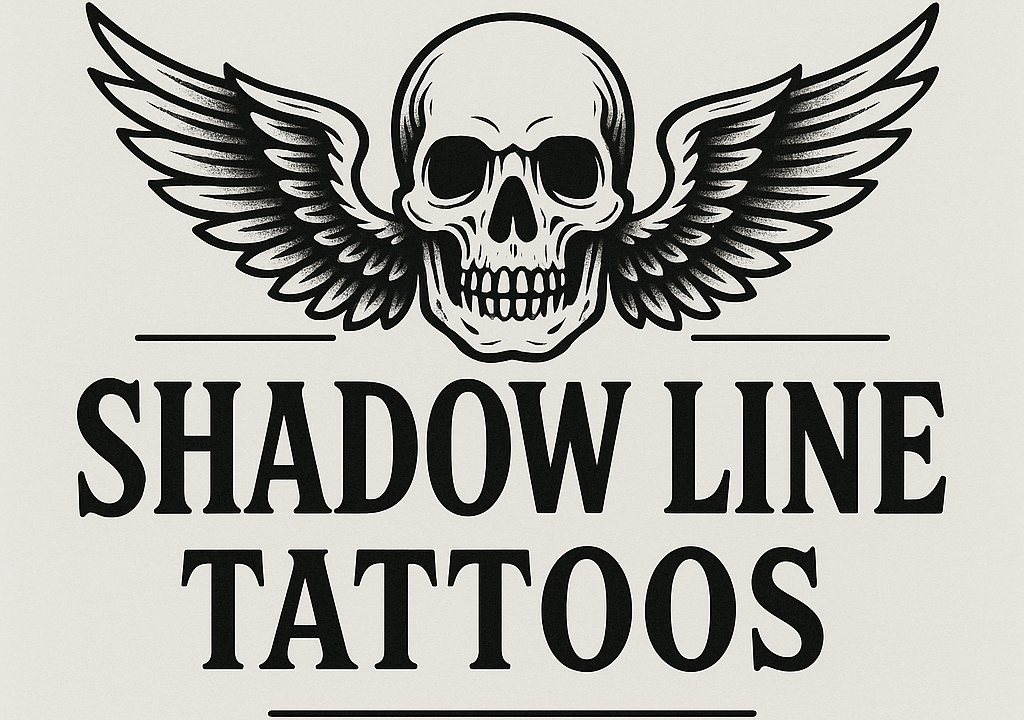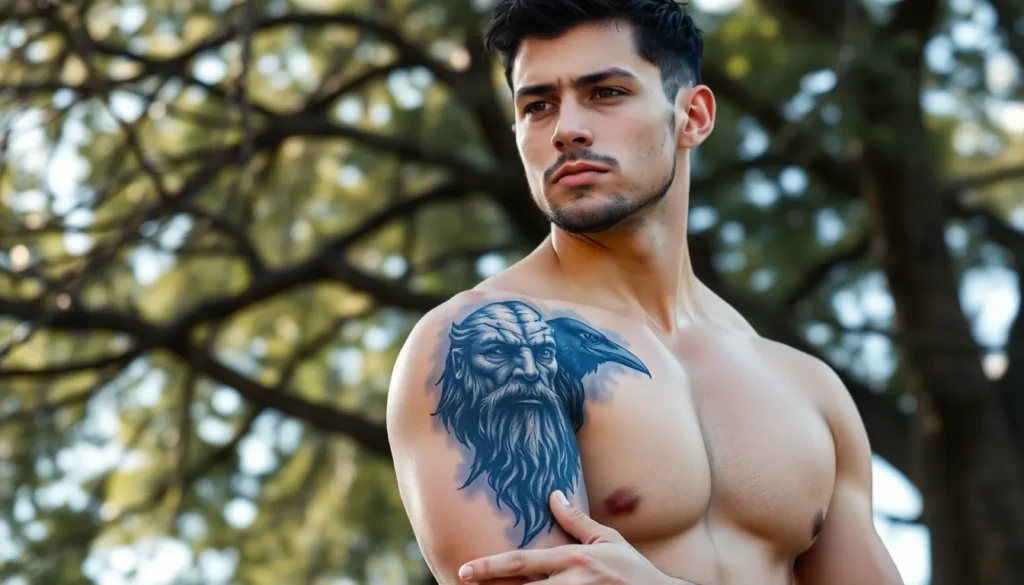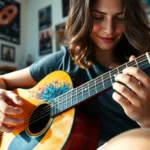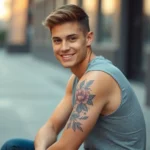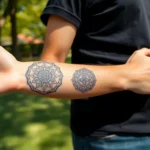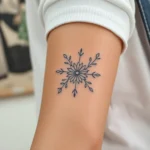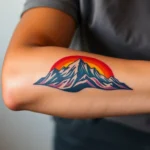Odin tattoos have surged in popularity as more people connect with Norse mythology’s most powerful and complex deity. The All-Father represents wisdom, war, death, and magic – making him an incredibly rich subject for tattoo art that tells a deeper story about the wearer’s values and beliefs.
We’ve seen countless interpretations of Odin tattoos, from traditional Nordic designs featuring his iconic ravens Huginn and Muninn to modern artistic renditions that blend contemporary tattooing techniques with ancient symbolism. Whether you’re drawn to his role as the wise wanderer seeking knowledge or the fierce warrior god leading the Wild Hunt, there’s an Odin tattoo design that’ll perfectly capture your connection to this legendary figure.
The beauty of Odin tattoo ideas lies in their versatility and symbolic depth. You can incorporate elements like his eight-legged horse Sleipnir, the mystical runes he discovered, or his legendary spear Gungnir to create a truly personalized piece that honors both Norse heritage and your individual journey.
Traditional Norse Odin Tattoo Designs
Traditional Norse Odin tattoo designs draw from authentic historical imagery and ancient artistic styles found in Viking art and archaeological discoveries.
The All-Father Portrait
Classic depictions of Odin feature his weathered face with a single piercing eye, often surrounded by intricate knotwork patterns. Artists typically emphasize his long beard flowing with traditional Norse braiding techniques, while his remaining eye holds an intensity that speaks to his sacrifice for wisdom. We see these portraits incorporating authentic Viking age artistic elements like interlacing designs, geometric patterns, and bold linework reminiscent of stone carvings from the medieval period.
Detailed facial features in traditional Odin portraits often include deep wrinkles that tell stories of countless battles and endless quests for knowledge. His missing eye socket becomes a powerful focal point, sometimes filled with shadow or adorned with runic symbols that reference his sacrifice at Mimir’s well. Many traditional designs frame the All-Father’s face with his iconic wide-brimmed hat or a crown of ravens’ feathers, creating a composition that honors historical Norse artistic conventions.
Odin With His Ravens Huginn and Muninn
Huginn and Muninn representations in traditional tattoos position the ravens as Odin’s most trusted companions, typically perched on his shoulders or flying around his figure. These designs emphasize the birds’ role as his eyes and ears throughout the nine realms, often depicting them with outstretched wings that create ever-changing movement within the composition. We observe how traditional Norse art styles influence these tattoos through the use of bold, angular lines and symbolic representations rather than realistic portrayals.
Symbolic positioning of the ravens varies between different traditional approaches, with some designs showing them whispering secrets into Odin’s ears while others depict them in flight carrying messages across vast distances. The ravens’ feathers often incorporate runic inscriptions or traditional Norse patterns, connecting the birds to the broader mythology surrounding Odin’s search for universal knowledge. These tattoos frequently use the contrast between the dark ravens and lighter background elements to create visual depth and emphasize the mystical connection between the All-Father and his winged messengers.
Sleipnir Eight-Legged Horse Imagery
Sleipnir depictions in traditional Norse tattoo art showcase Odin’s supernatural steed with all eight legs clearly defined, often shown in full gallop across the skies or through the realms of Norse cosmology. Traditional designs emphasize the horse’s otherworldly nature through flowing manes that seem to merge with clouds or wind patterns, while the eight legs create a sense of movement that defies natural physics. We find these tattoos incorporating authentic Viking age artistic elements like spiral motifs and interlacing patterns that flow seamlessly with Sleipnir’s form.
Ever-changing compositions featuring Sleipnir often show Odin mounted on his magnificent steed, creating scenes that capture their journeys between the industry tree Yggdrasil’s branches. The horse’s eight legs allow tattoo artists to create complex, symmetrical designs that work well with the natural curves of human anatomy, particularly on larger canvas areas like backs and chests. Traditional Norse artistic conventions influence these designs through the use of bold outlines, geometric patterns within the horse’s body, and symbolic elements like runic inscriptions along Sleipnir’s neck or saddle that reference exact mythological tales.
Modern Minimalist Odin Tattoo Ideas
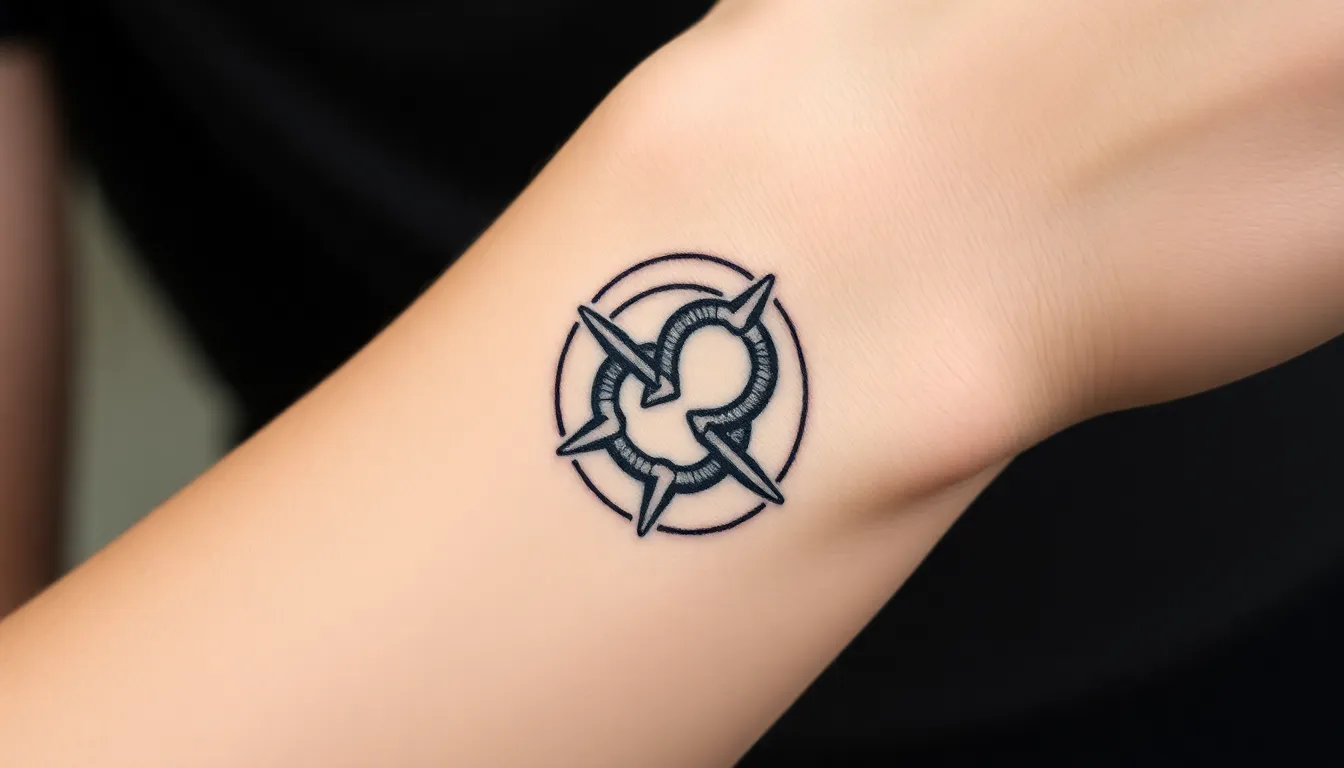
Contemporary Odin tattoo designs embrace clean lines and simplified forms while maintaining the powerful symbolism of Norse mythology. These modern interpretations offer sophisticated alternatives to traditional detailed artwork.
Simple Valknut Symbol
Valknut tattoos represent one of the most striking minimalist approaches to honoring Odin. This three-interlocked-triangle symbol connects directly to the All-Father as the “knot of the slain,” making it perfect for those seeking subtle Norse symbolism.
Clean geometric lines create the most effective Valknut designs. We recommend focusing on precise angles and consistent line weights to achieve that modern aesthetic. The symbol works exceptionally well as a small wrist piece or behind-the-ear placement.
Linear interpretations of the Valknut eliminate unnecessary details while preserving its power. Simple black ink creates bold contrast, though some clients prefer subtle gray shading to add depth without compromising the minimalist approach.
Geometric Gungnir Spear Design
Gungnir transformations into geometric patterns offer endless creative possibilities for modern tattoo enthusiasts. Odin’s legendary spear translates beautifully into angular, abstract representations that maintain its symbolic significance while embracing contemporary design principles.
Triangle compositions form the foundation of most geometric Gungnir designs. We often see artists incorporating hexagonal patterns or diamond shapes to create the spear’s shaft, while maintaining the pointed tip through sharp angular elements.
Minimal color palettes enhance the geometric impact of these designs. Black ink remains the most popular choice, though subtle gold or silver accents can highlight exact geometric elements without overwhelming the overall composition.
Abstract spear representations work particularly well on forearms and calves. The elongated nature of Gungnir suits these body placements perfectly, allowing the geometric patterns to flow naturally with muscle contours.
Abstract Odin’s Eye Representation
Abstract eye interpretations capture Odin’s wisdom sacrifice through symbolic rather than literal imagery. These designs focus on the concept of sight, knowledge, and sacrifice without depicting a realistic human eye.
Circular motifs form the core of most abstract Odin eye tattoos. We’ve seen stunning examples using concentric circles, spiral patterns, or overlapping geometric shapes to represent the All-Father’s single remaining eye and his pursuit of wisdom.
Watercolor techniques add ethereal qualities to abstract eye designs. Soft color washes in blues, grays, or earth tones create dreamy backgrounds that emphasize the mystical aspects of Odin’s sacrifice at Mimir’s well.
Spiral elements connect to both wisdom and the cosmic nature of Odin’s knowledge. These flowing patterns work beautifully on shoulders or upper arms, where the curved lines complement natural body movement while maintaining the tattoo’s symbolic power.
Sleeve and Large-Scale Odin Tattoo Concepts
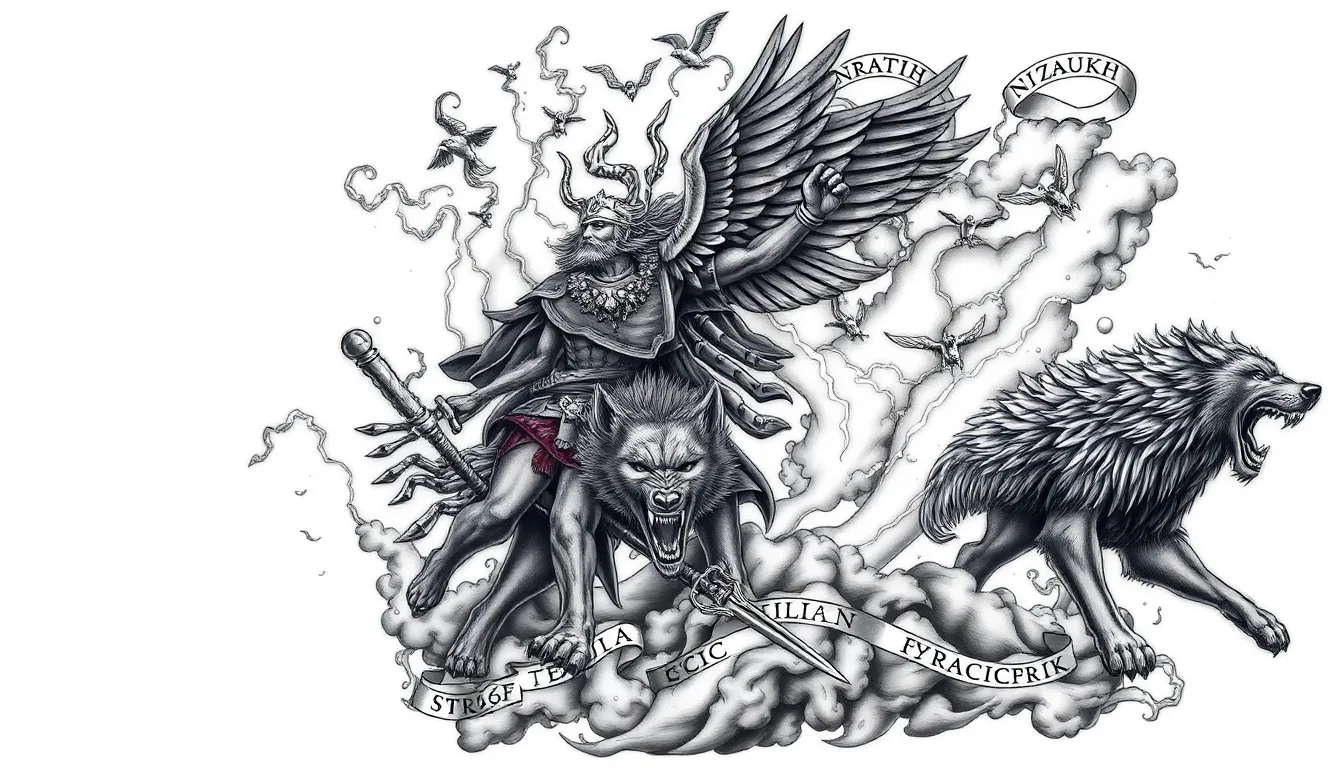
Expansive tattoo designs allow us to explore Odin’s mythology with incredible detail and storytelling depth. These large-scale concepts transform our bodies into canvases for Norse legends, incorporating multiple mythological elements into cohesive, breathtaking artwork.
Full Arm Ragnarok Battle Scenes
Apocalyptic battle scenes depicting Ragnarok create some of the most dramatic sleeve tattoos we can envision. Ever-changing compositions showcase Odin leading the Einherjar against the forces of chaos, with Valkyries swooping through storm clouds and the Wolf Fenrir bearing down on the Allfather himself.
Artists often render these scenes with powerful black and gray tones, adding strategic highlights to weapons and lightning strikes for maximum visual impact. Shattered spears and broken shields scattered throughout the design emphasize the epic nature of this final battle, while the Bifrost bridge stretches across portions of the sleeve to connect different mythological realms.
Background elements like swirling storm clouds and crackling energy bolts fill negative spaces, creating movement that draws the eye around the entire arm. Strategic placement of runic inscriptions within the battle chaos adds authentic Norse touches without overwhelming the primary imagery.
Back Piece Yggdrasil With Odin
Massive back tattoos featuring the Industry Tree offer us unparalleled opportunities for detailed Norse mythology artwork. Yggdrasil’s gnarled roots and expansive branches span the entire back canvas, with Odin positioned thoughtfully beneath or beside the ancient tree in contemplative poses that reflect his search for wisdom.
Complex root systems often extend down toward the lower back, while nine distinct branches reach toward the shoulders, each representing one of the Norse realms. Huginn and Muninn perch strategically within the tree’s canopy, their watchful eyes surveying the design from elevated positions.
Intricate Nordic knotwork frames these designs, weaving between roots and branches to create visual borders that enhance the overall composition. Artists frequently include the serpent Nidhogg gnawing at the tree’s base, adding another layer of mythological authenticity to these expansive pieces.
Detailed bark textures and leaf patterns provide opportunities for masterful shading work, while Odin’s weathered features and flowing robes create focal points that anchor the entire design.
Chest Panel Valhalla Gates
Majestic chest tattoos depicting Valhalla’s legendary gates create powerful warrior-centric designs that span from shoulder to shoulder. Massive wooden or iron gates dominate the central chest area, adorned with authentic runic inscriptions and flanked by crossed spears and battle shields.
Odin appears in the foreground of these designs, often accompanied by Valkyries whose flowing forms guide fallen warriors toward the hall’s entrance. Mead halls and stormy skies stretch across the upper chest and shoulder areas, creating atmospheric backgrounds that enhance the mythological setting.
Strategic use of architectural elements like stone columns and metal reinforcements adds realistic detail to the gate structures, while battle-worn weapons scattered at the base suggest countless warriors have passed through these sacred portals. Ravens frequently perch atop the gates, serving as Odin’s eternal sentinels watching over Valhalla’s entrance.
These chest pieces work exceptionally well with existing shoulder or arm tattoos, allowing for seamless integration of multiple Norse mythology elements across larger body areas.
Odin Symbol Tattoo Variations
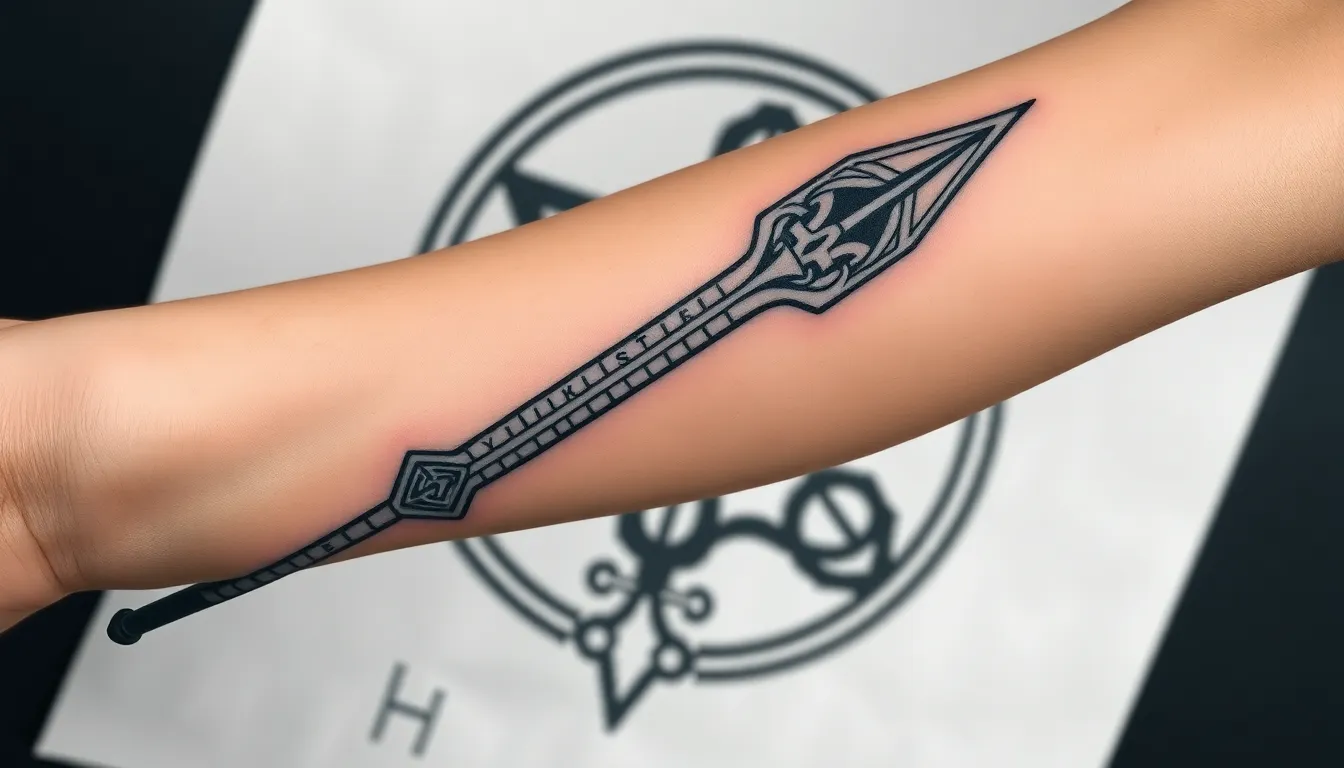
Odin’s mythological symbols offer diverse tattoo possibilities that capture different aspects of the All-Father’s power and wisdom. These distinctive elements can stand alone or combine with other Norse imagery to create meaningful body art.
Gungnir Spear Tattoos
Gungnir represents protection and unwavering determination in Norse mythology. This legendary weapon never misses its target, making it a powerful symbol for those who pursue their goals with focused commitment. Tattoo artists often depict Gungnir with intricate runic inscriptions along its shaft, emphasizing its magical properties and connection to divine power.
Design variations include:
- Vertical spear placements along the forearm or spine
- Crossed spear arrangements symbolizing protection from multiple directions
- Detailed engravings featuring Norse knotwork and runic alphabets
- Minimalist line work focusing on the spear’s distinctive pointed tip
Valknut Triangle Designs
Valknut tattoos symbolize courage and the warrior spirit through three interlocking triangles. This powerful symbol represents Odin’s three aspects: god of war, wisdom, and death, making it particularly meaningful for those seeking spiritual protection. Contemporary tattoo artists interpret the Valknut in various styles, from traditional bold black ink to geometric patterns with precise angles.
Popular placement options are:
- Shoulder blade positioning for symbolic protection
- Chest placements near the heart for personal significance
- Wrist locations as daily reminders of inner strength
- Integration within larger Norse mythology scenes
Odin’s Horns Drinking Vessel
Odin’s association with the mead of poetry creates opportunities for unique horn-inspired tattoo designs. These symbols connect to his pursuit of wisdom and knowledge, particularly his theft of the sacred mead that granted poetic inspiration. Artists often incorporate flowing designs that suggest liquid movement, representing the flow of wisdom and creative inspiration.
- Curved horn shapes with Celtic knotwork details
- Flowing mead designs using watercolor techniques
- Combined imagery with ravens or wolves drinking alongside Odin
- Abstract representations focusing on the vessel’s symbolic meaning rather than literal form
Realistic Portrait Odin Tattoo Styles
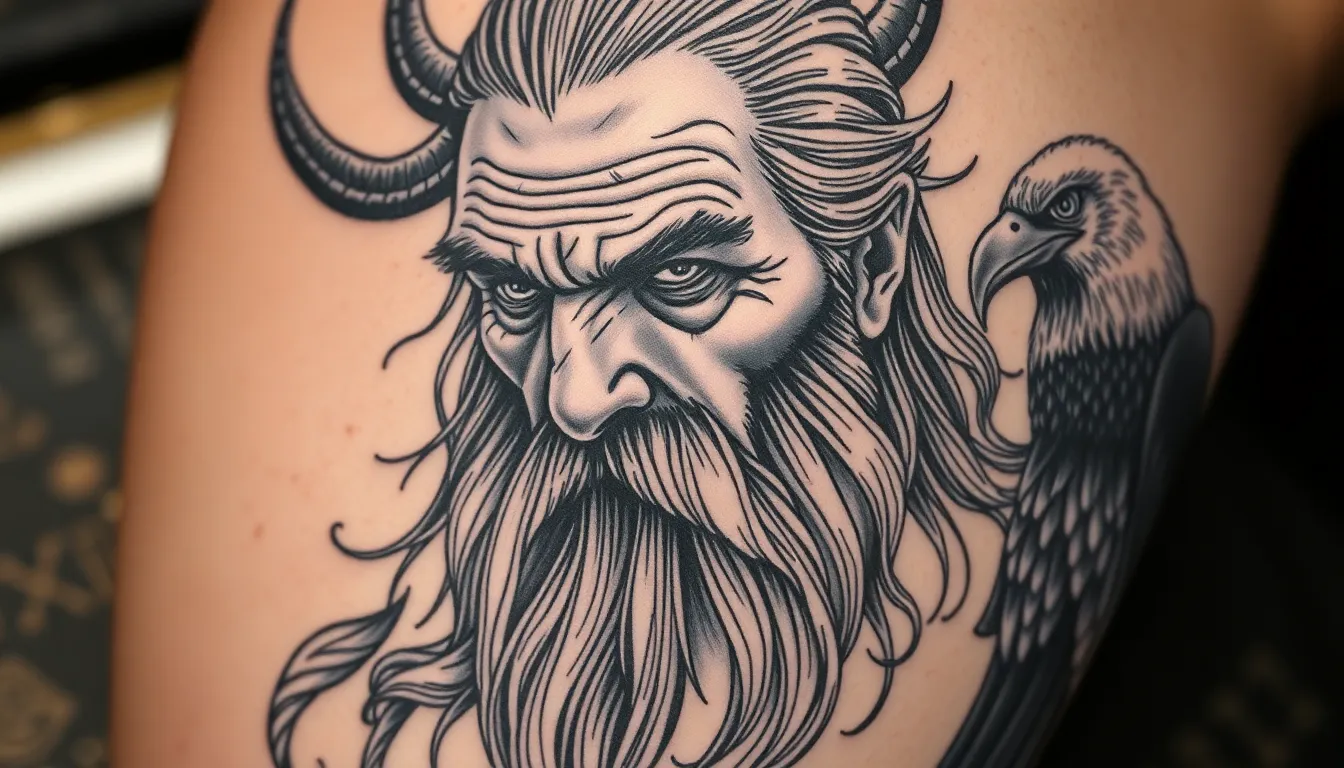
We see realistic portrait tattoos capturing Odin’s majestic presence through lifelike detail and artistic precision. These designs transform the All-Father into stunning visual narratives that honor his complex mythology.
Black and Gray Elderly Odin
Monochromatic elderly Odin portraits showcase the wisdom etched into every line of his weathered face. Artists emphasize deep shadows around his single piercing eye while highlighting the texture of his flowing beard through masterful gray gradients. We recommend incorporating subtle details like crow’s feet and forehead wrinkles to convey centuries of accumulated knowledge and sacrifice.
Bold contrasts between light and dark create dramatic depth in these black and gray compositions. The absence of color forces viewers to focus on Odin’s intense expression and the stories written across his ancient features. Skilled tattoo artists often position Huginn and Muninn within the negative spaces surrounding his portrait, creating a cohesive design that speaks to his connection with divine wisdom.
Strategic shading techniques bring dimension to his iconic wide-brimmed hat while maintaining the mysterious shadows that partially conceal his face. We find that placing these portraits on larger canvas areas like the back or thigh allows artists to capture the intricate details that make elderly Odin so compelling.
Colored Battle-Ready All-Father
Vibrant battle-ready Odin portraits burst with ever-changing energy through rich blues, deep reds, and golden accents. Artists typically depict him in full warrior regalia with Gungnir gleaming in metallic tones while his armor reflects light through carefully applied highlights. We see these designs incorporating flowing capes in deep royal blues or storm grays that suggest movement and power.
Electric blue eyes often serve as the focal point in these colored portraits, drawing attention to Odin’s divine nature and supernatural awareness. The addition of color allows artists to emphasize his connection to lightning and storms through purple and silver atmospheric effects surrounding his figure. Battle scars and war paint details become more pronounced when rendered in realistic flesh tones contrasted against darker elements.
Sleipnir frequently appears in these compositions, with his coat rendered in rich browns or mystical grays that complement Odin’s armor. We recommend discussing color saturation with your artist to ensure the final piece maintains its vibrancy over time while capturing the All-Father’s commanding presence on the battlefield.
Weathered Wanderer Odin
Rugged wanderer portraits focus on Odin’s role as the eternal seeker of knowledge and wisdom. These designs emphasize travel-worn clothing, sun-damaged skin, and the accumulated dust of countless journeys across the nine realms. Artists achieve this weathered appearance through subtle color variations and texture work that suggests years of exposure to harsh elements.
Worn leather details on his traveling cloak and staff create authentic aging effects that tell stories of his wandering years. We notice that successful wanderer portraits often include environmental elements like wind-blown hair or cloak edges that suggest movement and restlessness. The overall composition maintains an earthy color palette with muted browns, grays, and faded blues that reinforce his connection to the natural industry.
Facial hair typically appears less groomed in these interpretations, with realistic individual hair textures that catch light naturally. Strategic placement of small details like travel bags, worn rope, or weathered boots adds authenticity to the wanderer theme while maintaining focus on Odin’s determined expression and far-seeing gaze.
Celtic-Norse Fusion Odin Tattoo Ideas
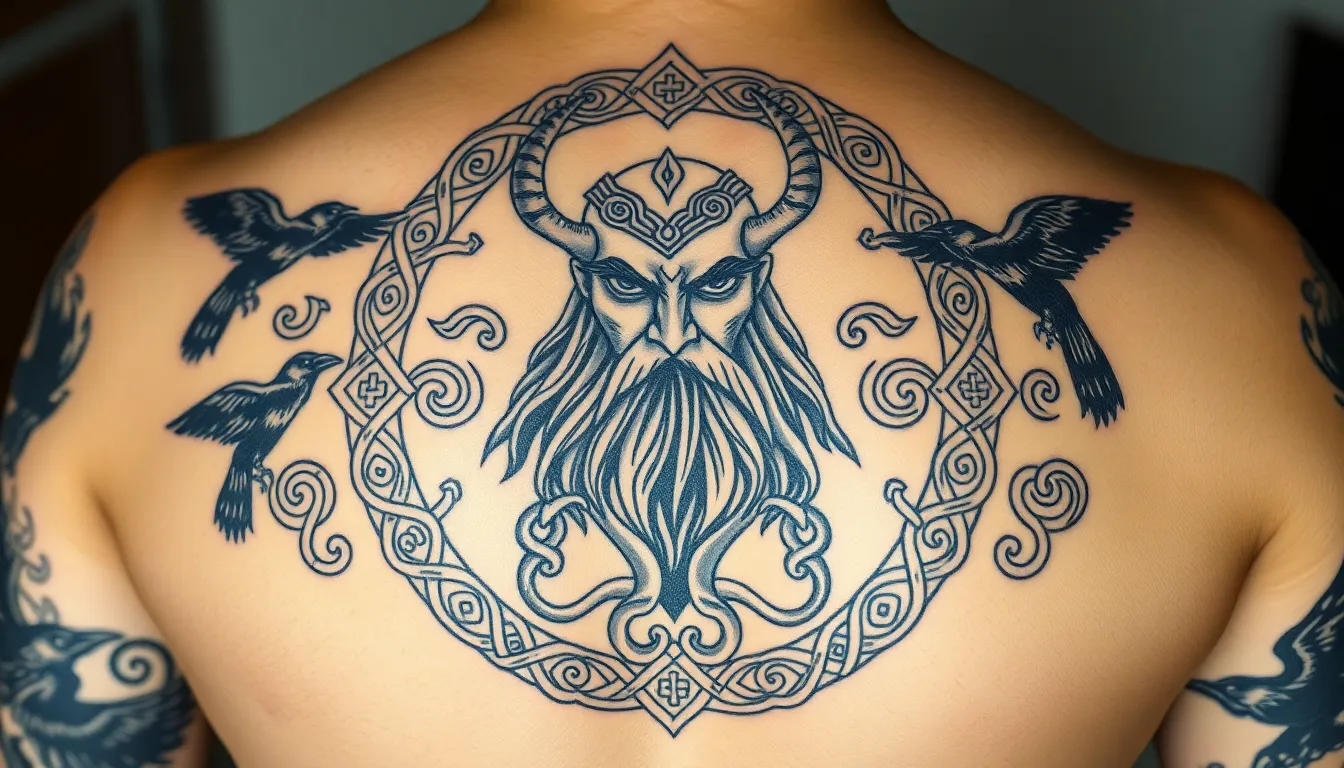
Blending Celtic artistry with Norse mythology creates stunning tattoo designs that honor two rich cultural traditions. These fusion concepts allow us to explore unique artistic expressions while maintaining deep symbolic meaning.
Knotwork Integrated Designs
Celtic knots frame Odin’s image beautifully, creating visually complex designs that merge two ancient art forms. We often see these patterns surrounding portraits of the All-Father, with intricate loops and interwoven lines forming natural borders that enhance the central figure. Incorporating Norse runes within the knotwork adds layers of meaning, as each runic symbol carries exact wisdom that Odin himself discovered through sacrifice.
Blending techniques involve interweaving Celtic spirals with Norse motifs like Yggdrasil’s branches or Odin’s ravens. Artists frequently use the endless nature of Celtic knots to represent eternal wisdom, while Norse elements ground the design in Odin’s mythology. These integrated patterns work exceptionally well as sleeve components or chest pieces, where the flowing knotwork can naturally follow body contours.
Celtic Odin Tree of Life
Tree of life symbols merge seamlessly with Odin’s association to the Industry Tree Yggdrasil, creating powerful representations of cosmic connection. We see these designs featuring Celtic branching patterns intertwined with Norse runic inscriptions, emphasizing both cultures’ reverence for sacred trees. The Celtic tree traditionally represents the connection between earth and sky, perfectly complementing Odin’s role as a bridge between realms.
Interwoven elements enhance these tree designs through the addition of Celtic spirals wrapping around trunk sections and Norse ravens perched among branches. Artists often incorporate Odin’s sacrificial imagery, showing him hanging from branches adorned with Celtic knotwork, creating a visual narrative that speaks to both traditions’ understanding of wisdom through sacrifice. These designs work beautifully as back pieces or large thigh tattoos where the tree can sprawl naturally.
Interlaced Raven Patterns
Raven motifs appear in interlaced patterns that echo Celtic manuscript illuminations while honoring Huginn and Muninn’s role as Odin’s messengers. We frequently observe these designs featuring ravens with wings that transform into Celtic knotwork, creating seamless transitions between Norse symbolism and Celtic artistry. The birds’ feathers often incorporate spiral patterns reminiscent of Celtic coins and jewelry designs.
Symbolic connections strengthen when artists emphasize ravens’ association with wisdom through Celtic eye motifs woven into wing patterns. These designs commonly feature interlocking ravens forming circular compositions, similar to Celtic animal interlace found in medieval manuscripts. We recommend these patterns for shoulder placements or forearm wraps, where the interlaced design can flow around the arm’s natural curves while maintaining visual balance between both cultural elements.
Placement Ideas for Odin Tattoos
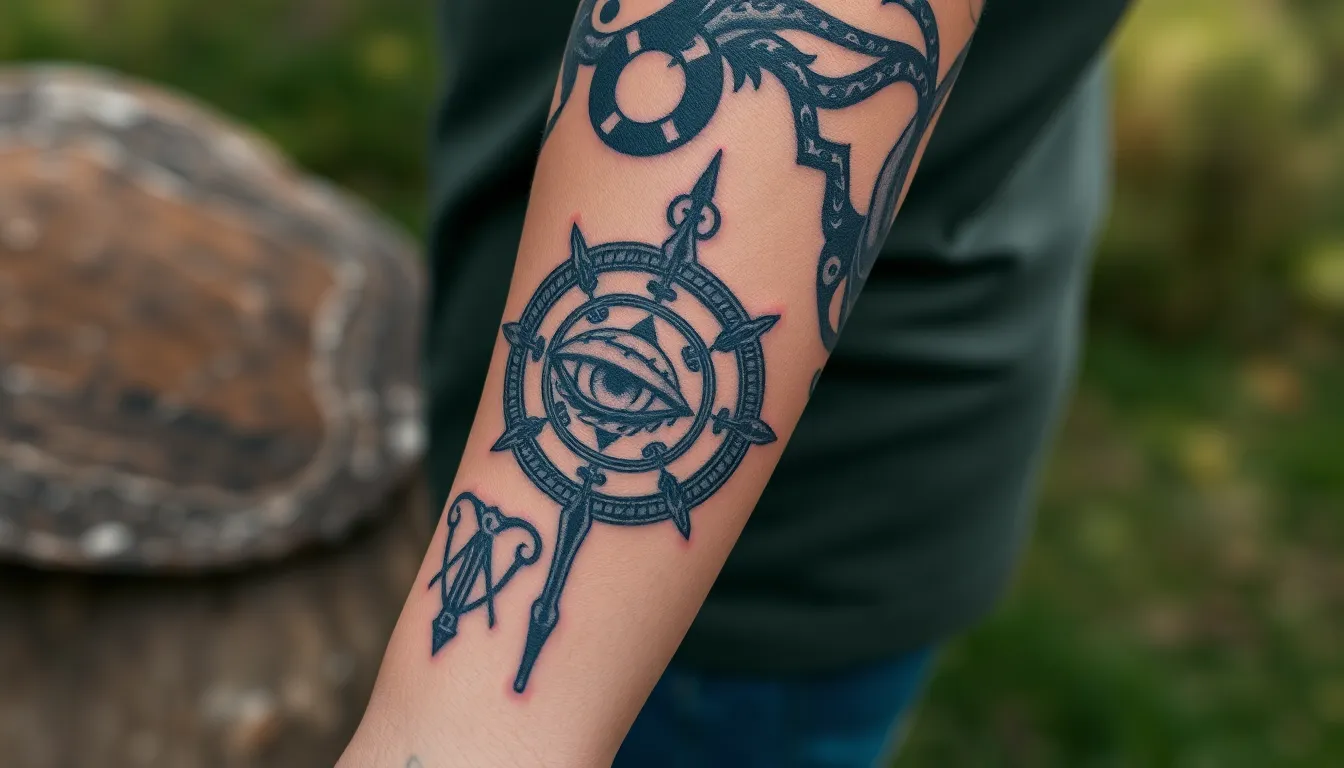
Choosing the right placement for your Odin tattoo significantly impacts both its visual impact and personal meaning. We’ll explore the most popular locations that showcase these powerful Norse designs effectively.
Forearm Odin Tattoo Options
Forearm placements offer the perfect balance between visibility and discretion for Odin tattoo designs. You can easily display your Norse mythology tribute during social gatherings while maintaining the option to cover it for professional settings. We recommend smaller, more focused designs for this area, such as Odin’s piercing eye surrounded by runes or a simplified Valknut symbol.
The forearm’s elongated canvas works exceptionally well for vertical compositions featuring Gungnir or stylized ravens in flight. Professional environments become less of a concern since you can quickly conceal the tattoo with long sleeves when necessary. Artists often suggest this placement for first time tattoo recipients because the forearm experiences moderate pain levels compared to more sensitive areas.
Shoulder and Upper Arm Designs
Shoulder and upper arm locations provide an ideal canvas for intricate and grand Odin tattoo concepts. These areas accommodate larger, more detailed designs while offering relatively comfortable tattooing experiences with minimal pain compared to other body locations. We find that clients appreciate this placement for its versatility in showcasing complex Norse mythology scenes.
The curved surface of the shoulder naturally complements circular designs like the Valknut or Odin’s ravens positioned around his portrait. Upper arm placements work brilliantly for wrapping designs that can extend into sleeve concepts over time. You’ll discover that this area heals efficiently and maintains tattoo clarity exceptionally well due to consistent muscle tone and reduced skin stretching.
Back and Chest Placement Tips
Back and chest areas deliver the most dramatic visual impact for expansive Odin tattoo designs. These locations offer ample space for detailed, comprehensive Norse mythology scenes featuring Odin surrounded by runes, Yggdrasil, or his symbolic animals like Huginn and Muninn. We recommend these placements for clients seeking to create powerful storytelling pieces that capture multiple aspects of the All Father’s legend.
The back serves as an excellent canvas for vertical compositions showing Odin’s journey through the nine realms or his sacrifice at Yggdrasil. Chest placements work particularly well for symmetrical designs featuring Odin’s face flanked by his ravens or crossed spears representing Gungnir. These areas require longer tattooing sessions but reward you with stunning, museum quality artwork that showcases the full complexity of Norse symbolism.
Conclusion
We’ve explored the vast industry of Odin tattoo possibilities from traditional Norse designs to modern artistic interpretations. Whether you’re drawn to the All-Father’s piercing gaze or the intricate symbolism of his ravens and eight-legged steed these tattoos offer endless creative potential.
The beauty of Odin tattoos lies in their adaptability to personal style and placement preferences. From minimalist Valknut symbols to elaborate Celtic-Norse fusion pieces each design tells a unique story while honoring ancient mythology.
Remember that choosing the right artist who understands Norse symbolism and can execute your vision is crucial. Take time to research thoroughly and communicate your ideas clearly to ensure your Odin tattoo becomes a meaningful piece of art you’ll treasure for years to come.
Frequently Asked Questions
What makes Odin tattoos so popular among tattoo enthusiasts?
Odin tattoos have gained popularity due to the Norse god’s complex symbolism representing wisdom, war, death, and magic. His rich mythology offers versatile design options that allow wearers to express personal values and connect with Norse heritage. The combination of traditional Nordic elements and modern artistic interpretations appeals to diverse tattoo preferences.
What are the most common traditional Norse Odin tattoo designs?
Traditional Norse Odin tattoos typically feature his weathered face with a single piercing eye, intricate knotwork patterns, and his wide-brimmed hat or raven-feathered crown. These designs often incorporate his ravens Huginn and Muninn, eight-legged horse Sleipnir, and geometric patterns using bold outlines that reflect authentic Viking artistic styles.
Can Odin tattoos be done in minimalist styles?
Yes, modern minimalist Odin tattoos are increasingly popular. These designs focus on simplified elements like the Valknut symbol, geometric representations of Gungnir (his spear), and abstract interpretations of Odin’s eye using circular motifs. Watercolor techniques and clean lines create contemporary versions that appeal to minimalist tattoo enthusiasts.
What Celtic-Norse fusion elements work well in Odin tattoos?
Celtic-Norse fusion tattoos blend intricate Celtic knotwork with Norse mythology, creating unique designs. Popular elements include Celtic spirals integrated with Norse motifs, the Celtic tree of life intertwined with Yggdrasil, and interlaced raven patterns echoing Celtic manuscript illuminations while honoring Huginn and Muninn’s symbolic significance.
Where are the best placement options for Odin tattoos?
Odin tattoo placement depends on design size and complexity. Forearms work well for smaller designs, while shoulders and upper arms accommodate intricate pieces. Back and chest areas are ideal for expansive storytelling tattoos featuring detailed Norse mythology scenes. Each placement offers different visual impact and comfort levels during tattooing.
What symbols can be incorporated into Odin tattoo designs?
Odin tattoos can incorporate various Norse symbols including his ravens (Huginn and Muninn), eight-legged horse Sleipnir, spear Gungnir, the Valknut symbol, Norse runes, and Yggdrasil (the World Tree). These elements can be combined to create personalized designs that honor both Norse heritage and individual stories.
